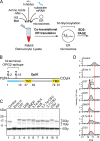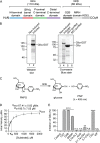Characterizing the selectivity of ER α-glucosidase inhibitors
- PMID: 30976784
- PMCID: PMC6583763
- DOI: 10.1093/glycob/cwz029
Characterizing the selectivity of ER α-glucosidase inhibitors
Erratum in
-
Correction to: Characterizing the selectivity of ER α-glucosidase inhibitors.Glycobiology. 2023 Jun 21;33(6):525. doi: 10.1093/glycob/cwad017. Glycobiology. 2023. PMID: 36975755 Free PMC article. No abstract available.
Abstract
The endoplasmic reticulum (ER) contains both α-glucosidases and α-mannosidases which process the N-linked oligosaccharides of newly synthesized glycoproteins and thereby facilitate polypeptide folding and glycoprotein quality control. By acting as structural mimetics, iminosugars can selectively inhibit these ER localized α-glycosidases, preventing N-glycan trimming and providing a molecular basis for their therapeutic applications. In this study, we investigate the effects of a panel of nine iminosugars on the actions of ER luminal α-glucosidase I and α-glucosidase II. Using ER microsomes to recapitulate authentic protein N-glycosylation and oligosaccharide processing, we identify five iminosugars that selectively inhibit N-glycan trimming. Comparison of their inhibitory activities in ER microsomes against their effects on purified ER α-glucosidase II, suggests that 3,7a-diepi-alexine acts as a selective inhibitor of ER α-glucosidase I. The other active iminosugars all inhibit α-glucosidase II and, having identified 1,4-dideoxy-1,4-imino-D-arabinitol (DAB) as the most effective of these compounds, we use in silico modeling to understand the molecular basis for this enhanced activity. Taken together, our work identifies the C-3 substituted pyrrolizidines casuarine and 3,7a-diepi-alexine as promising "second-generation" iminosugar inhibitors.
Keywords: N-linked glycosylation; endoplasmic reticulum; glucose trimming; iminosugar inhibitors.
© The Author(s) 2019. Published by Oxford University Press.
Figures






Similar articles
-
Casuarine stereoisomers from achiral substrates: chemoenzymatic synthesis and inhibitory properties.J Org Chem. 2014 Jun 6;79(11):5386-9. doi: 10.1021/jo500991p. Epub 2014 May 14. J Org Chem. 2014. PMID: 24810734
-
Inhibitory properties of 1,4-dideoxy-1,4-imino-d-arabinitol (DAB) derivatives acting on glycogen metabolising enzymes.Org Biomol Chem. 2016 Sep 26;14(38):9105-9113. doi: 10.1039/c6ob01543c. Org Biomol Chem. 2016. PMID: 27714243 Free PMC article.
-
N-Substituted Valiolamine Derivatives as Potent Inhibitors of Endoplasmic Reticulum α-Glucosidases I and II with Antiviral Activity.J Med Chem. 2021 Dec 23;64(24):18010-18024. doi: 10.1021/acs.jmedchem.1c01377. Epub 2021 Dec 6. J Med Chem. 2021. PMID: 34870992
-
Mechanisms of Antiviral Activity of Iminosugars Against Dengue Virus.Adv Exp Med Biol. 2018;1062:277-301. doi: 10.1007/978-981-10-8727-1_20. Adv Exp Med Biol. 2018. PMID: 29845540 Free PMC article. Review.
-
Antiviral therapies targeting host ER alpha-glucosidases: current status and future directions.Antiviral Res. 2013 Sep;99(3):251-60. doi: 10.1016/j.antiviral.2013.06.011. Epub 2013 Jun 29. Antiviral Res. 2013. PMID: 23816430 Free PMC article. Review.
Cited by
-
Development of iminosugar-based glycosidase inhibitors as drug candidates for SARS-CoV-2 virus via molecular modelling and in vitro studies.J Enzyme Inhib Med Chem. 2024 Dec;39(1):2289007. doi: 10.1080/14756366.2023.2289007. Epub 2023 Dec 12. J Enzyme Inhib Med Chem. 2024. PMID: 38086763 Free PMC article.
-
Synthesis of Pyrrolidine Monocyclic Analogues of Pochonicine and Its Stereoisomers: Pursuit ofSimplified Structures and Potent β-N-Acetylhexosaminidase Inhibition.Molecules. 2020 Mar 25;25(7):1498. doi: 10.3390/molecules25071498. Molecules. 2020. PMID: 32218360 Free PMC article.
-
(-)-Epigallocatechin-3-Gallate and Quercetin Inhibit Quiescin Sulfhydryl Oxidase 1 Secretion from Hepatocellular Carcinoma Cells.Antioxidants (Basel). 2025 Jan 17;14(1):106. doi: 10.3390/antiox14010106. Antioxidants (Basel). 2025. PMID: 39857439 Free PMC article.
-
An alternative pathway for membrane protein biogenesis at the endoplasmic reticulum.Commun Biol. 2021 Jul 1;4(1):828. doi: 10.1038/s42003-021-02363-z. Commun Biol. 2021. PMID: 34211117 Free PMC article.
-
The glycosylation in SARS-CoV-2 and its receptor ACE2.Signal Transduct Target Ther. 2021 Nov 15;6(1):396. doi: 10.1038/s41392-021-00809-8. Signal Transduct Target Ther. 2021. PMID: 34782609 Free PMC article. Review.
References
-
- Asano N. 2008. Glycosidase-inhibiting alkaloids: isolation, structure and application In: Fattorusso E, Taglialatela-Scafati O, editors. Modern Alkaloids: Structure, Isolation, Synthesis and Biology. Weinheim: Wiley-VCH Verlag; p. 111–138.
-
- Asano N, Nash RJ, Molyneux RJ, Fleet GWJ. 2000. Sugar-mimic glycosidase inhibitors: natural occurrence, biological activity and prospects for therapeutic application. Tetrahedron: Asymmetry. 11:1645–1680.
-
- Asano N, Oseki K, Kizu H, Matsui K. 1994. Nitrogen-in-the-ring pyranoses and furanoses: structural basis of inhibition of mammalian glycosidases. J Med Chem. 37:3701–3706. - PubMed
Publication types
MeSH terms
Substances
Grants and funding
LinkOut - more resources
Full Text Sources
Molecular Biology Databases
Miscellaneous

